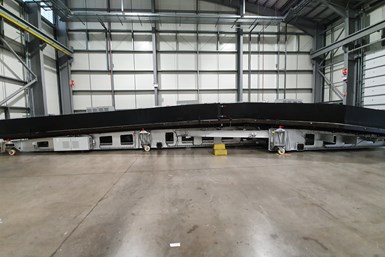Airbus completes assembly of Wing of Tomorrow prototype
The Wing of Tomorrow integrates myriad new composite materials and processing technologies, including thermoplastic composite ribs, an out-of-autoclave vacuum bag only spar, infused skins and much more.
These thermoplastic aircraft wing ribs were fabricated by GKN Aerospace for the Airbus Wing of Tomorrow demonstrator. Photo Credit: GKN Aerospace
Airbus (Tolouse, France) announced at the 2022 Farnborough International Airshow on July 20 that its transnational R&T program, Wing of Tomorrow (WOT), has successfully delivered a first full-size wing demonstrator that will help mature next-generation wing technologies.
The completion of the first of three fully composite wing demonstrators marks the integration of more than 100 component and manufacturing technologies that include an all-new industrial assembly system, and which have helped validate key automation targets. The wing includes many applications of innovative composites M&P, including thermoplastic ribs, an OOA VBO rear spar, infused skins, newly designed leading edge spars and more. Click #wingoftomorrow for all CW coverage of the WOT program.
Daher fabricated this rear spar structure for the Airbus Wing of Tomorrow program using OOA and VBO technologies. Photo Credit: Daher
Sabine Klauke, Airbus CTO, says, “Wing of Tomorrow brings a completely different build philosophy to the way we currently assemble wings and is a crucial part of our R&T portfolio that will help us assess the industrial feasibility of wing production in the future.”
The international team behind this U.K.-led program is developing high-performing wing technologies, including the incorporation of a folding wing tip. Alongside research into sustainable aviation fuels and hydrogen propulsion, WOT shows how Airbus is contributing to aviation’s decarbonization ambitions and demonstrates the importance of large-scale industry collaboration in achieving the aerospace sector’s agenda for a more sustainable future.
The new build philosophy on WOT eradicates in-tank working and enables manual and automated assembly to be smoothly integrated into an optimized industrial system. Through capturing the learning from building this first, and subsequent, wing demonstrators, Airbus will explore different scenarios to be able to make the right industrial choices to build our wings of the future.
Spirit AeroSystems in Prestwick, Scotland, used this 17-meter mold to infuse the lower wing skin for the Airbus Wing of Tomorrow program. Photo Credit: Spirit AeroSystems
Airbus says WOT composite components are designed to make the best use of technologies and reduce the amount of work during the assembly phase by more than 50%. Automation of the remaining drilling, achieving good tolerance control and wing shape, as well as the introduction of new approaches to inspection and validation will support Airbus’ ambition to create the most highly efficient wings of the future.
Related Content
-
Thermoplastic composites welding advances for more sustainable airframes
Multiple demonstrators help various welding technologies approach TRL 6 in the quest for lighter weight, lower cost.
-
Novel dry tape for liquid molded composites
MTorres seeks to enable next-gen aircraft and open new markets for composites with low-cost, high-permeability tapes and versatile, high-speed production lines.
-
Materials & Processes: Composites fibers and resins
Compared to legacy materials like steel, aluminum, iron and titanium, composites are still coming of age, and only just now are being better understood by design and manufacturing engineers. However, composites’ physical properties — combined with unbeatable light weight — make them undeniably attractive.



















